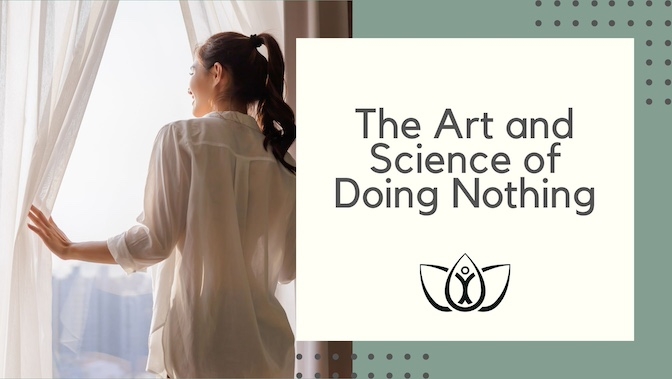This blog post was written by Victoria L. Freeman, Ph.D., CHFS, CMH, CBC, and reviewed by Lauren Ameling, DC, BCND.
The Dutch have a celebrated concept called “Niksen,” which, when translated, means "to do nothing or be idle.” The Italians have a phrase called “Dolce far Niente” that translates to “the sweetness of doing nothing.” Asian philosophy offers a non-striving concept called “Wu-Wei,” meaning “inexertion or effortless action.” In America, when people decide to do nothing, we call them “lazy, bums, or loafers.” Quite a contrast, isn’t it?
While we don’t want to turn our backs on productivity, there is something we can learn from these other cultures who seem to reject the “live-to-work” mentality so prevalent in U.S. society. Could we and should we learn to embrace idleness a little more often? The short answer is YES, and this article addresses why and how.
The Art and Science of Doing Nothing
The Scientific Benefits of Doing Nothing
In his book Autopilot: The Art and Science of Doing Nothing, Andrew Smart states that “being idle is one of the most important activities in life,”1 and he goes on to present extensive neuroscientific evidence to support this claim. He writes, “… your brain needs to rest, right now. While our minds are exquisitely evolved for intense action, in order to function normally, our brains also need to be idle – a lot of the time, it turns out.”1
Chronic busyness is bad for your brain, but it also has serious holistic health consequences, such as destroying creativity, self-knowledge, emotional well-being, social fitness, and even cardiovascular health. In contrast, disengaging, unplugging, or becoming idle allows your brain to become more active in areas like the hippocampus, the medial prefrontal cortex, the precuneus, and the anterior cingulate cortex, collectively regions that Smart refers to as the “Default Mode Network (DMN) or the “Resting State Network” (RSN).1 When we’re focused on performing a specific task, this same brain network deactivates or shuts down. So, idleness equates to a more organized and engaged DMN, whereas being busy or focusing on a specific task translates to a less active DMN.
Why does this matter? Because neuroscience indicates that an active DMN, facilitated by idleness, makes your brain work better. The Default Mode Network or Resting State Network was discovered in 2001 by neuroscientist Marcus Raichle at Washington University in St. Louis, Missouri.1 When Raichle had research subjects lie in a magnetic resonance imaging (MRI) scanner and perform demanding cognitive tasks, he found some areas of brain activity lit up, but some decreased. This finding was surprising because, before this time, scientists commonly believed that all brain activity only increased during a cognitive task challenge compared to another lesser challenge or a “flat baseline.”1 However, Raichle discovered that this specific brain network increased activity when subjects “disengaged from the outside world.”1 In other words, when subjects were lying in the scanner with their eyes closed doing nothing, brain activity did not decrease; it simply switched places. These regions – the DMN or RSN – that deactivate during tasks become more active at rest.
Many areas of the brain are specialized for performing certain tasks, Smart explains. For example, the visual cortex processes visual information, while the amygdala generates warnings and is involved in activating the sympathetic nervous system to “fight or flee.” The DMN specializes in mind-wandering or daydreaming. But perhaps most interestingly, those “aha” moments when you experience flashes of insight or creative problem-solving seem to occur more often in those who allow their brain’s resting-state network time to reverberate.1 This tells us that your brain isn’t just sitting there waiting for the next stimulation. Instead, it is perpetually and spontaneously active in maintaining, responding, predicting, and interpreting. In fact, your brain uses more energy for spontaneous activity than it does to perform your multiplication tables or fill in a spreadsheet.1
When your brain is constantly bombarded by stimuli from emails, text messages, meetings, errands, and to-do lists, it can become overwhelmed by “the challenge of the moment.”1 Obviously, we need to be able to respond to challenges as they arise. Sometimes, our lives depend on that ability. But when those moments become all day, every day, your brain has no time left over to make novel connections, find patterns, and have new ideas. In short, it has no time to be creative.1
Given this perspective on brain functionality, it’s probably no accident that as our working hours increase to an extreme, our mental health and physical well-being decrease. Allowing yourself time to do nothing gives your brain a chance to process experiences, consolidate memories, and reinforce learning. Your resting state is a powerful tool for regulating your emotions and maintaining your ability to focus. Rest can also help you make better decisions and, paradoxically, be more productive.
This leads us to an important lesson: embrace your downtime without feeling guilty. When you learn this skill, you can become more at peace with yourself, more focused when you need to be, and allow new ideas to come to the surface that can lead you into novel, meaningful, and satisfying directions.
Soaking in those serene moments can benefit your body, too. Doing nothing can encourage a more parasympathetic state for your nervous system that, in turn, can boost relaxation, lower blood pressure, improve digestion, relieve anxiety and depression, and release muscle tension. Who doesn’t need that?
The Art of Doing Nothing: What Does It Look Like?
How can you tell if you're successfully "doing nothing"? In a doing-nothing state, your mind should be free to roam, not worrying about anything or obsessing about your to-do list. These time-outs remove you from routine expectations and allow space to think differently about who you are or should be.
Like an airplane, Smart says your brain has an “autopilot,” which takes over when we enter a resting state and relinquish manual control.1 This autopilot is your DMN or RSN. The goal is to (at least occasionally) stop flying your plane and, instead, let your autopilot guide you. For example, it could be as simple as doing nothing while waiting in traffic, in line at the grocery store, or at a doctor’s appointment. Don’t check your email, don’t read a magazine, don’t make a phone call or text. Just be. Or you could observe a “digital sabbath,” meaning a period of time away from all digital devices such as phones, computers, or televisions … maybe even for an entire day!
This video may inspire some ideas for you, but in the meantime, consider these ways you can encourage your autopilot to take over:
* meditate
* take slow, deep breaths
* soak in nature
* take a nap
* gaze out a window
* daydream
* stroke a pet
Here’s a little five-minute jumpstart to ease into nothingness. Start small and expand the time and experiences as you’re able.
1. Find a time when you can stop what you’re doing (yes, you can!). That means really, truly just stop.
2. Sit or lie down in a quiet place.
3. Notice your breath or listen to the sounds around you. In other words, be present.
4. Focus on what it feels like to breathe in through your nose and out through your mouth.
5. Silence your thoughts as best you can. Observe them, but don’t get involved in them.
6. Slow down your breathing. Breathe in for four seconds, hold for four seconds, and then breathe out for four seconds. Repeat.
7. When your mind wanders (and it will), observe your thoughts but don’t engage with them. Are your thoughts genuine and kind? If not, replace them with thoughts that are or return to noticing your breath.
Focus On Being Rather Than Doing
Need more incentive for a respite? Doing nothing may even make you kinder. Sometimes, being alone with your thoughts reveals a greater sense of purpose, encouraging you to try altruistic activities that extend beyond yourself, such as volunteering for a charity, helping a friend in need, or other community service. At first, it may feel lazy to take a time-out when there are still dirty dishes in the sink and clothes on the floor, but instead of viewing the time as “unproductive,” think of it as an investment in your physical, mental, and spiritual health. Because that’s truly what it is.
To learn more about how to live a holistically healthy life, check into Trinity’s Certified Natural Health Professional program at https://trinityschool.org/program/cnhp, or call an enrollment specialist today at 800-428-0408, option 2.
References
1. Smart, A. (2023). Auto-Pilot: The Art & Science of Doing Nothing. FINGERPRINT!: New Delhi, India.
ABOUT THE AUTHOR:
 Victoria L. Freeman, Ph.D., CHFS, CMH, CBC, has traveled a long and winding professional road that includes working as a teenage fine artist, later a personal trainer and wellness coach, a college professor and administrator in exercise science and education, a freelance natural health and fitness writer for national magazines, a property manager and interior designer for vacation and executive rental properties and most recently returning to the natural health arena while attending Trinity School of Natural Health to become a Certified Holistic Fitness Specialist, a Certified Master Herbalist, and a Certified Biblical Coach.
Victoria L. Freeman, Ph.D., CHFS, CMH, CBC, has traveled a long and winding professional road that includes working as a teenage fine artist, later a personal trainer and wellness coach, a college professor and administrator in exercise science and education, a freelance natural health and fitness writer for national magazines, a property manager and interior designer for vacation and executive rental properties and most recently returning to the natural health arena while attending Trinity School of Natural Health to become a Certified Holistic Fitness Specialist, a Certified Master Herbalist, and a Certified Biblical Coach.

